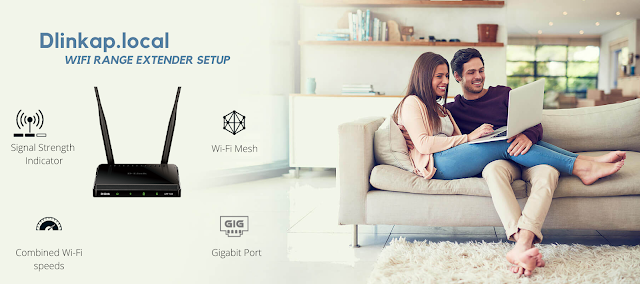A Step-by-Step Guide to Setting Up Your Rockspace Device with re.rockspace.local
In today's digital world, a strong and reliable Wi-Fi connection is no longer a luxury, it's a necessity. Whether you're streaming movies, keeping up with loved ones on video calls, or battling it out in online games, a sluggish or spotty Wi-Fi signal can put a damper on your entire experience.
If you've recently purchased a re.rockspace.local or range extender, you're well on your way to achieving Wi-Fi nirvana! This guide will walk you through the setup process using re.rockspace.local, a user-friendly web interface that allows you to configure your Rockspace device in no time.
Before We Begin:
Before diving into the setup, gather a few things to make the process smoother:
Your Rockspace device (router or range extender)
A power outlet for your Rockspace device
An Ethernet cable (optional, but recommended for initial setup)
Your existing Wi-Fi network name and password (if using a range extender)
A computer, laptop, smartphone, or tablet with a Wi-Fi connection
Step 1: Power Up Your Rockspace Device
Find a suitable location for your Rockspace device. For routers, a central location within your home is ideal for optimal signal distribution. For range extenders, place it within range of your existing router's signal but closer to the area experiencing weak Wi-Fi coverage.
Plug the power adapter into your Rockspace device and then connect it to a power outlet.
Wait for the LED lights on your Rockspace device to turn on and stabilize. This might take a minute or two.
Step 2: Connect to Your Rockspace Device (Wired or Wireless)
Option 1: Wired Connection (Recommended)
Using the Ethernet cable provided with your Rockspace device (or one you have on hand), connect one end to an available Ethernet port on your computer and the other end to an Ethernet port on your re.rockspace.local or device (usually labeled LAN).
Once connected, your computer should automatically detect the Rockspace device and establish a connection. You might need to adjust your network settings depending on your operating system.
Option 2: Wireless Connection
On your computer, laptop, smartphone, or tablet, search for available Wi-Fi networks.
Look for the default SSID (network name) of your Rockspace device. This is typically printed on a label on the device itself and might be named something like "Rockspace_EXT" (for range extenders).
Select the Rockspace network and enter the default Wi-Fi password (also printed on the device label). This password is usually generic (like "admin" or "password") and is intended for initial setup.
Step 3: Access the re.rockspace.local Interface
Open a web browser on your connected device.
In the address bar, type re.rockspace.local and press Enter.
Note: If you encounter any issues accessing re.rockspace.local, don't worry! We'll troubleshoot this in a later step.
Step 4: Setting Up Your Rockspace Device
You should now be greeted by the Rockspace web interface. This interface might ask you to create an administrator account or log in with your existing Rockspace account details (if you have one).
Follow the on-screen instructions to complete the setup process. This typically involves:Setting a new Wi-Fi network name (SSID) and password for your Rockspace device (if you're setting up a router). Choose a unique and strong password to secure your network.
Selecting the Wi-Fi network you want to extend (if using a range extender). Enter the password for that network.
Customizing additional settings (optional). You might have options to configure guest networks, parental controls, bandwidth management, and more.
Step 5: Connecting Your Devices to the New Wi-Fi Network
Once the setup is complete, your Rockspace device will be ready to use.
On your various devices (computers, phones, tablets, etc.), search for available Wi-Fi networks and connect to the new SSID (network name) you created during setup.
Enter the password you set for the new network when prompted.
Step 6: Enjoy a Stronger and More Reliable Wi-Fi Connection!
You've successfully set up your Rockspace device using re.rockspace.local! Now, you should experience a more robust and far-reaching Wi-Fi signal throughout your home.
How to Fix the Troubleshooting?
Having trouble accessing re.rockspace.local during your Rockspace device setup?
Don't worry, these troubleshooting tips can get you back on track:
Double-check everything: Ensure you typed the address exactly (re.rockspace.local) and verify your device's connection. If wired, check the Ethernet cable. If wireless, confirm you're connected to the default Rockspace Wi-Fi network with the correct password (both found on the device label).
Clear your browsing data and try a different device: Sometimes cached data disrupts website loading. Clear your browser's cache and cookies, then restart it and try again. If the issue persists, use a different device (computer, phone, etc.) to access Www.re.rockspace.local. This helps identify if the problem lies with your device or the Rockspace setup.
Restart and consult resources: A simple restart can often fix glitches. Power cycle your Rockspace device and the device you're using. If none of the above work, consult your Rockspace device manual or contact Rockspace support for further assistance.
Conclusion
With a strong Wi-Fi signal thanks to your Rockspace device, you can now stream, game, and connect seamlessly throughout your home. Just make sure, if you encounter any setup issues, the troubleshooting tips provided will help you get back on track!
Related post: What is the role of wifi.wavlink.com in router firmware updates?




Comments
Post a Comment